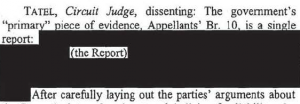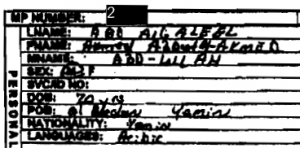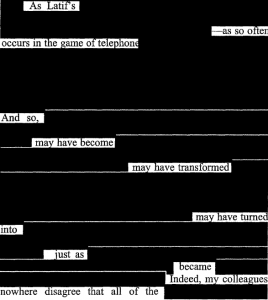The Government Continues to Play Redaction Games with Latif
I’ve now read all the documents the government issued and reissued on April 30 in some detail (District Court Opinion; Circuit Opinion; Cert Petition; Government Response; Latif Reply). As I’ve noted, in addition to releasing their own response to Adnan Farhan Abd al Latif’s cert petition, the government also released less-redacted versions of the previous filings in the case.
As it turns out, the government primarily released a lot of stuff that would make Janice Rogers Brown’s opinion look less batshit crazy, if you ignore that they had been hiding her Wizard of Oz analogy in the name of national security. For example, it released information making it clear that all the government’s data on whether Latif is married or not is inconsistent, which of course is all blamed on Latif.
The ploy seems to have worked; Ben Wittes, who seems unconcerned that three reports on Latif (his DOD intake form and two conflicting reports from the same interview at Gitmo) prove that such intelligence reports cannot practically be afforded the presumption of regularity without the government’s own case files–and frankly, their case here–falling apart, now thinks “Judge Brown’s reading of [the evidence against Latif] strikes me as very likely preferable to the one the district court adopted.”
That said, with the newly released information, I’m increasingly convinced they’re using the redaction process not to protect national security, but to cheat.
The redactions get worse to make it harder to find problems with the government’s recruiter story
There are a few examples where in this round, the government has actually redacted more information on the second round–mostly information on Ibrahm al-Alawi starting on page 10 in the District Court opinion (compare the “less redacted version” with the original release). Since this stuff is all already available in other documents, this mostly amounts to pettiness, but it does serve to hide a central part of the government’s argument. They claim the similarities between Latif’s story about the charity worker Ibrahim al-Alawi and the known al Qaeda recruiter Ibrahim Balawi (who is usually called Abu Khalud) provides corroboration for the government’s story. Yet none of the eight or so detainees recruited by Abu Khalud IDed Latif. And–as I hope to show–the records on these other detainees suggest they should have been able to, if Abu Khalud and al-Alawi were really the same guy. In other words, while this redaction doesn’t limit the amount of information out there, it does make it harder for people to quickly see how flimsy one crucial part of the government’s argument is.
Adding half a line in the redaction process
More curious appears on page 1 (PDF 68) of the Tatel’s opinion. There appear to be about half a line-which is redacted–that has been added to the third and fourth line of the opinion. As a result, Tatel’s reference to “(the Report)” is shifted onto the next line and the alignment of the entire rest of the paragraph changes.
Here’s the original release:
And here’s the latest release:
Now, the space is about what a reference to the document name–TD-314/00684-02–would take up on the line. Maybe they’ve simply added that. But still, what’s the protocol for just adding something into the record just before SCOTUS reviews it? Did Tatel approve this addition?
Hiding Latif’s explanations for how TD-314/00684-02 implicated him
There’s another apparent redaction that–if I’m right about its content–serves to prevent us from seeing a thoroughly unclassified but nevertheless critical part of Latif’s (or perhaps just David Tatel’s) argument. There are repeated discussions of Latif’s theory for how TD-314/00684-02 got so screwed up as to implicate him in fighting for the Taliban. Kennedy discusses it at 14–though almost all the explanations remain redacted. Rogers Brown summarizes these at 4, though one clause remains redacted.
But Latif says his statements were misunderstood or, alternatively, [redacted] were misattributed to him.
There’s a long discussion on 26 in Rogers Brown and on 24-25 (PDF 92-93) in Tatel. All of these have been newly released in significant part. Except for a key part of Tatel’s argument.







